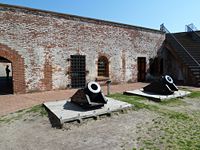Fort Macon: Difference between revisions
John Stanton (talk | contribs) No edit summary |
John Stanton (talk | contribs) No edit summary |
||
| Line 38: | Line 38: | ||
== Current Status == | == Current Status == | ||
[[Image:Fort Macon Marker.jpg|thumb|left|200px|Fort Macon Marker]] | [[Image:Fort Macon Marker.jpg|thumb|left|200px|Fort Macon Marker]] | ||
Restored and operating as a North Carolina State Park. | Restored and operating as a North Carolina State Park. Three replica cannons on carriages and two original 10" siege mortars in place. | ||
{{Clr}} | {{Clr}} | ||
Revision as of 05:52, 20 March 2012
Fort Macon (1834-1877, 1898-1903, 1941-1945) - A U.S. Army Third System masonry fort begun in 1826 and first garrisoned in Dec 1834. Named after Nathaniel Macon. Abandoned by the U.S. Army in 1903 but reoccupied by U.S. Army troops from Dec 1941 to Nov 1944 during World War II and finally returned to the state 1 Oct 1946.
 |
 |
 | |
 | |
Third System (1816-1867)
Established to protect the entrance to the harbor at Beaufort and Morehead City, North Carolina.

Fort Macon is a Third System fort designed by Brigadier General Simon Bernard and built by the U.S. Army Corps of Engineers between 1826 and 1834. From it's completion in 1834 until the start of the U.S. Civil War in 1861 it was garrisoned for less than six years and in the hands of a single caretaker most of that time.
The inner structure of the fort is shaped as an irregular pentagon and constructed of brick and stone masonry. It has 26 casemates enclosed by walls that average 4 1/2 feet thick. Three of the five sides face seaward. The inner structure is surrounded by a ditch with two drawbridge entrances. The ditch is surrounded by a high earthwork with additional gun emplacements. The fort was designed to mount 51 seacoast cannon. See Weaver, pages 139-141 for a detailed description.
The fort was upgraded between 1841 and 1846.
U.S. Civil War (1861-1865)

The fort was in the hands of a caretaker when the U.S. Civil War began on 12 Apr 1861. The North Carolina Militia seized control of the fort two days later and began upgrading the armament in anticipation of a Union attack. The fort remained in Confederate hands for a year before Union forces under Brigadier General John G. Parke mounted a siege. The siege included land base gun and mortar batteries south of the fort, a fleet of gunboats offshore and floating batteries in the sound. Some of the Union land batteries were using new rifled cannon and their fire proved too much for the masonry fort. When the fort's magazines became exposed and vulnerable, the Confederate fort commander, Colonel Moses J. White, surrendered on 26 Apr 1862. The fort remained in Union hands for the duration of the war.
After the war the fort became a Federal prison for both civilian and military prisoners. In 1877 the fort was placed back in caretaker status.
Endicott Period (1890-1910)
In 1898, during the Spanish American War, the fort was garrisoned by North Carolina troops briefly. The importance of the sound and Beaufort harbor had declined and Fort Macon was not selected to receive any of the Endicott Period concrete gun batteries. Older guns were remounted and batteries reactivated that included two 100-pounder Parrott rifles, two 10" siege mortars and two 12-pounder field guns. By 10 Oct 1903 the fort is listed as having no armament and in poor condition with a number of arches about to fall owing to the irregular settlement of the foundation. The fort was completely abandoned in 1903.
World War II (1941-1945)
Fort Macon was taken over by the Federal government and regarrisoned during World War II. Initially a single battery of four, 155mm GPF guns in field mounts was set up just southwest of the old fort. A cantonment of barracks and support buildings was set up outside the walls of the old fort. The 155mm battery was replaced in 1942 by a battery of two 6" guns in concrete emplacements.
In 1946 the reservation was returned to the State of North Carolina.
Current Status

Restored and operating as a North Carolina State Park. Three replica cannons on carriages and two original 10" siege mortars in place.
|
{"selectable":false,"width":"500"} |
Location: Fort Macon State Park is located in Carteret County on the eastern end of Bogue Banks. From I-95, take US 70 east to Morehead City and turn south on Atlantic Beach Causeway. Cross the bridge to Atlantic Beach and turn left on NC 58. The fort is located at the tip of the island. Maps & Images Lat: 34.696179 Long: -76.678798 |
Sources:
- Roberts, Robert B., Encyclopedia of Historic Forts: The Military, Pioneer, and Trading Posts of the United States, Macmillan, New York, 1988, 10th printing, ISBN 0-02-926880-X, page 619-620
- Weaver, John R. II, A Legacy in Brick and Stone: America Coastal Defense Forts of the Third System, Redoubt Press, McLean, 2001, First Printing, ISBN 1-57510-069-X, page 139-141
- Branch, Paul, Fort Macon A History , Copyright 1999, Nautical & Aviation Publishing Company of America, ISBN 1-877853-45-3
Links:
- North American Forts - Fort Macon
- North American Forts - Fort Macon History
- North Carolina Parks - Fort Macon
- Wikipedia - Fort Macon
Visited: 17 Mar 2012, 19 Mar 2012
Fort Macon Picture Gallery
|
Click on the picture to see a larger version. Contribute additional pictures - the more the better! |